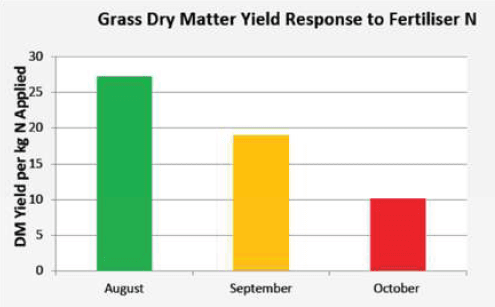Get a 24 hour weather forecast
Our priority for August is the maximise milk protein % and slow the milk yield decline while building grass across the month – Cows at Grass
We must gain about 2 days in rotation every week during August or increase average farm cover by up to 450 kgDM/cow across the month.
To achieve this increase in grass levels we must:
– Grow a lot of grass
– Lower our feed demand to allow for grass covers to build
Building a wedge of grass in August:
PastureBase Ireland data clearly demonstrates that many dairy farmers end up with less grass than they should on the 1st of September. This can result in cows’ intakes being squeezed, accelerated yield declines and low levels of milk lactose. Of all the years, with our current strong milk price we need to act now to prevent this.
In early August the target is to spread a unit N/day, at a 21 day rotation you should be spreading 21 units N/acre. Make sure you have the allowance left. There is an opportunity to skip or halve the fertilizer N applied on paddocks with a high clover content (30% plus) at this time of the year. Clover is at its most active at this time of the year and will fix N to replace chemical N fertilizer.
Recent Teagasc trial results illustrating the grass dry matter yield response to N fertilizer applications at three different timing in the Autumn. Source David Wall and Ian Fox, Teagasc Johnstown Castle.

Lowering grass demand in August – Cows at Grass
To build grass in August we need to lower of demand to less than our growth. Grass grows on average 55-65kgDM/Ha per day in August. A cow will eat c.18kg DM per day.
Every 1.25kg of concentrates you feed will lower cows grass DM requirement by 1kg DM.
Grass demand at 1.5kg of meal and differing stocking rates
| Current Diet for 28 kg average | ||||
| Grass (kg DM) | 16.5 | |||
| Concentrates (kg) | 1.5 | |||
| Stocking Rates (Lu/Ha) | 2.5 | 3 | 3.5 | 4 |
| Growth Needed to Meet Demand (Kg DM Per Day) | 41 | 50 | 58 | 66 |
To slow demand:
– Increase concentrate
– Introduce silage
Increasing concentrates is the preferred options as it maintains production better than silage.
Increasing concentrate feeding from 1.5 kg to 3kg will drop grass demand by 15%, increasing concentrate feeding from 1.5 kg to 6kg will drop grass demand by 30%.
Impact of differing measures on grass growth requirements to meet demand
| Stocking rate Lu/Ha) | 2.5 | 3 | 3.5 | 4 | |
| + 1.5kg per head. Total Concentrates
feed = 3kg per day |
Growth Needed to Meet Demand (KgDM Per Day) | 35 | 42 | 49 | 56 |
| + 4.5kg per head. Total Concentrates
feed = 6kg per day |
29 | 35 | 40 | 46 | |
| Buffer feed with 1 bale of grass
silage per 40 cows (1.5 kg conc + 1 bale) |
29 | 35 | 40 | 46 |
Silage is lower in UFL than grass or concentrates so while you will be meeting the cow’s intake requirements and this will hold production to some degree alone,
it will not maintain energy intakes and yields as good as a grass concentrate only option. But feeding silage is much better than leaving your cow short on intakes.
5kgs DM grass will supply 5UFLs, 5kgs DM concentrates will supply 5UFLs, 5kgs of silage will supply 3.75UFLs, 5kg of fresh air supply no UFLS.
The more concentrates and/or buffer you add the lower your grass demand.
Speak to us today for the best advice.